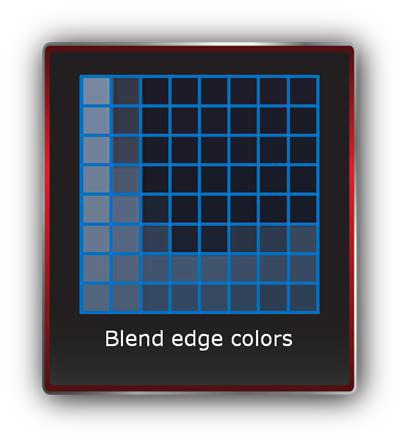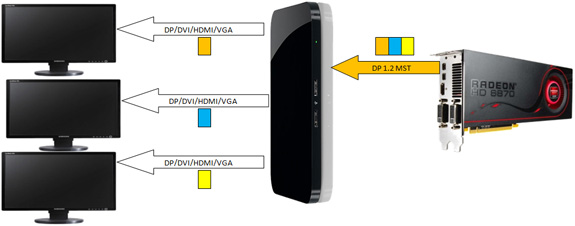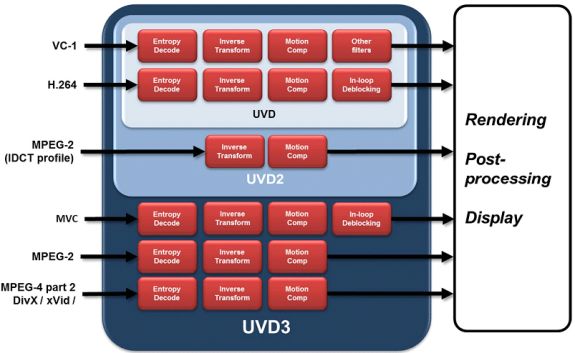AMD's Radeon HD 6970 & Radeon HD 6950: Paving The Future For AMD
by Ryan Smith on December 15, 2010 12:01 AM ESTRefresher: The 6800 Series’ New Features
Back in October AMD launched the first 6000 series cards, the Barts-based Radeon HD 6800 series. At their core they are a refreshed version of the Cypress GPU that we saw on the 5800 series, but AMD used the opportunity to make some enhancements over the standard Cypress. All of these enhancements apply throughout the 6000 series, so this includes the 6900 series. As such for those of you who didn’t pay much attention to the 6800 series, we’re going to quickly recap what’s new in order to lay the groundwork for further comparisons of the 6900 series to the 5800 series.
We’ll start with the core architecture. Compared to Cypress, Barts is nearly identical save 1 difference: the tessellator. For Barts AMD implemented what they call their 7th generation tessellator, which focused on delivering improved tessellation performance at lower tessellation factors that AMD felt were more important. Cayman takes this one step further and implements AMD’s 8th generation tessellator, which as the naming conventions implies is the 7th generation tessellator with even further enhancements (particularly those necessary for load balancing).
The second change we saw with Barts and the 6800 series was AMD’s refined texture filtering engine. AMD’s texture filtering engine from the 5800 set new standards by offering angle independent filtering, but it had an annoying quirk with highly regular/noisy textures where it didn’t do a good enough job blending together various mipmaps, resulting in visible transitions between them. For the 6800 series AMD fixed this, and it can now properly blend together noisy textures. At the same time in a controversial move AMD tweaked its default filtering optimizations for the 5800 series and entire 6000 series, leading to these cards producing imagines subtly different (and depending on who you ask, subtly worse) than they were on the 5800 series prior to the Catalyst 10.10 drivers.

| Radeon HD 5870 | Radeon HD 6870 | GeForce GTX 480 |
The third change we saw was the introduction of a new anti-aliasing mode, initially launched on the 6800 series and backported to the 5800 series shortly thereafter. Morphological Anti-Aliasing (MLAA) is a post-processing filter that works on any (and all) images, looking for high contrast edges (jaggies) and blending them to reduce the contrast. Implemented as a compute shader, it works with all games. As it’s a post-processing filter the results can vary – the filter has no knowledge of depth, polygons, or other attributes of the rendered world beyond the final image – so it’s prone to blending everything that looks like aliasing. On the plus side it’s cheap to use as it was originally designed for consoles with their limited resources, so by not consuming large amounts of memory & memory bandwidth like SSAA/MSAA it usually has a low performance hit.


Last but not least, AMD made a number of changes to their display hardware. The Universal Video Decoder (UVD) was upgraded to version 3, bringing full decode support for MPEG-2, MPEG-4 ASP, and H.264 MVC (packed frame video for 3D movies). For the 6900 series this is not of great importance as MPEG-2 and MPEG-4 ASP are low complexity codecs, but it does play an important role for AMD’s future APU products and low-end GPUs, where offloading these low complexity codecs is still going to be a big relief for the slower CPUs they’re paired with. And on that note the first public version of the DivX codec with support for UVD3 will be shipping today, letting 6800/6900 series owners finally take advantage of this functionality.
The second of the major display changes was the addition of support for the DisplayPort 1.2 standard. DP1.2 doubles DisplayPort’s bandwidth to 21.6Gbps, finally giving DisplayPort a significant bandwidth lead over dual-link DVI. With double the bandwidth it’s now possible to drive multiple monitors off of a single root DisplayPort, a technology called Multi Stream Transport (MST). AMD is heavily banking on this technology, as the additional bandwidth coupled with the fact that DisplayPort doesn’t require a clock source for each monitor/stream means AMD can drive up to 6 monitors off of a single card using only a pair of mini-DP ports. AMD is so cutting edge here that like the 6800 series the 6900 series is technically only DP1.2 ready – there won’t be any other devices available for compliance testing until 2011.

Finally, the 6800 series also introduced support for HDMI 1.4a and support for color correction in linear space. HDMI 1.4a support is fairly straightforward: the 6000 series can drive 3D televisions in either the 1080p24 or 720p60 3D modes. Meanwhile support for color correction in linear space allows AMD to offer accurate color correction for wide gamut monitors; previously there was a loss of accuracy as color correction had to be applied in the gamma color space, which is only meant for use for display purposes. This is particularly important for integrating wide gamut monitors in to traditional gamut workflows, as sRGB is misinterpreted on a wide gamut monitor without color correction.
While all of these features were introduced on the 6800 series, they’re fundamental parts of the entire 6000 series, meaning they’re part of the 6900 series too. This provides us with a baseline set of improvements over AMD’s 5800 series, on top of the additional improvements Cayman and AMD’s VLIW4 architecture brings.











168 Comments
View All Comments
anactoraaron - Wednesday, December 15, 2010 - link
I would like to thank Ryan for the article that makes me forget the "OC card in the review" debacle. Fantastic in depth review with no real slant to team green or red. Critics go elsewhere please.Hrel - Wednesday, December 15, 2010 - link
When are you guys gonna put all these cards in bench? Some of them have been out for a relatively long time now and they're still not in bench. Please put them in there.ajlueke - Wednesday, December 15, 2010 - link
I agree with most of the conclusions I have read here. If you already own a 5800 series card, there isn't really enough here to warrant an upgrade. Some improved features and slightly improved FPS in games doesn't quite give the same upgrade incentive as the 5870 did compared a 4870.There are some cool things with the 6900 and 6800 series. Looking at the performance in games, the 6970 and even the 6870 seemed to get much closer to 2X performance when placed in crossfire as compared to 5800 series cards. That is a pretty interesting development. All in all, a good upgrade if you didn't buy a card last generation. If you did, it seems the wait is on for the 28 nm version of the GPU.
Belard - Wednesday, December 15, 2010 - link
NO!The 800 cards were the HIGH end models since the 3000 series and worked well through to the 5000 series with the 5970 being the "odd one" since the "X2" made more sense like the 4850X2.
It also allows for a "x900" series if needed.
AMD needs to NOT COPY Nvidia's naming games... did they hire someone from Nvidia? Even the GeForce 580/570 still belong to the 400 series since its the same tech. SHould have been named 490 and the 475... But hey, in 12 months, Nvidia will be up to the 700 series. Hey, Google Chrome is version 8.0 and its been on the market for about 2 years! WTF?!
What was their excuse again? Oh, to not create confusion with the 5700 series? So they frack up the whole model names for a mid-range card? The 6800's should have been 6700s, simple as that. Yes, there will be some people who will accidentally downgrade.
What the new 6000 series has going for AMD is that they are somewhat cheaper and easily cost less to make than the 5000s and what Nvidia makes.
In the end, the 6000 series is the first dumb-thing AMD has done since the 2000 series, but nowhere near as bad.
MS - Wednesday, December 15, 2010 - link
In terms of effienct usage of space though AMD is doing quite well; ... should be efficientNice article so far,
Regards,
Michael
nitrousoxide - Wednesday, December 15, 2010 - link
The power connector on the left (8-pin of 6970 and 6-pin of 6950) has a corner (bottom left corner) cut down, that's because the cooler doesn't fit with the PCB design, if you install it with force the power connector would get stuck. So the delay of 6900 Series could be due to this issue, AMD needs one month to 'manually polish' all power connectors of the stock-cards in order to go with the cooler. Well, just a joke, but this surely reflects how poorly AMD organizes the whole design and manufacture process :)nitrousoxide - Wednesday, December 15, 2010 - link
you can find this out here :)hiphotos. baidu. com/coreavc/pic/item/70f48d81ffe07cf26d811957. jpg
nitrousoxide - Wednesday, December 15, 2010 - link
AMD promises that every one will get a unique 6970 or 6950, different from any other card on the planet :)GummiRaccoon - Wednesday, December 15, 2010 - link
The performance of these cards is much better with 10.12, why didn't you test it with that?Ryan Smith - Wednesday, December 15, 2010 - link
10.12 does not support the 6900 series.8.79.6.2RC2, dated December 7th, were the absolute latest drivers for the 6900 series at the time of publication.